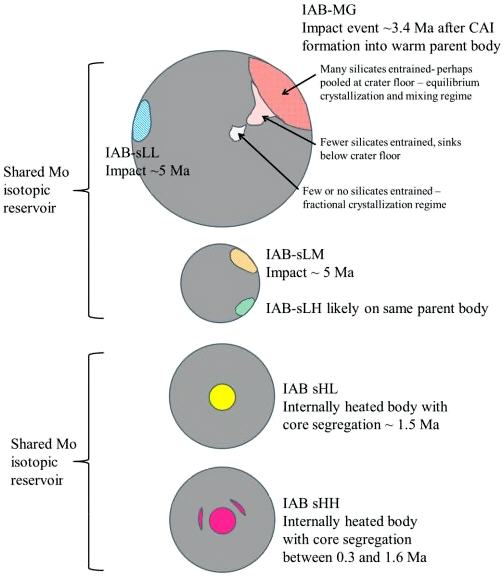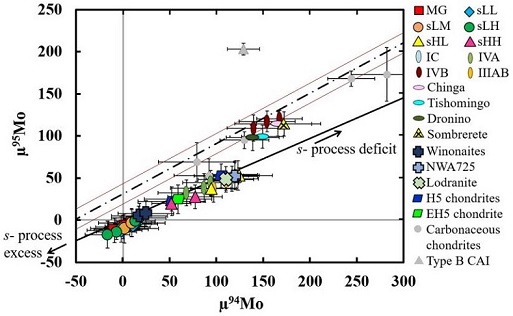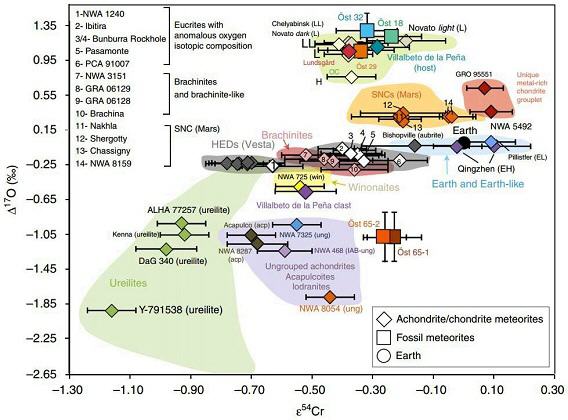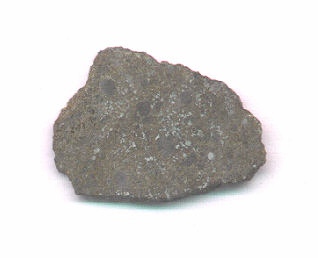NWA 725
ChondriteChondrites are the most common meteorites accounting for ~84% of falls. Chondrites are comprised mostly of Fe- and Mg-bearing silicate minerals (found in both chondrules and fine grained matrix), reduced Fe/Ni metal (found in various states like large blebs, small grains and/or even chondrule rims), and various refractory inclusions (such Click on Term to Read More, ungroupedModifying term used to describe meteorites that are mineralogically and/or chemically unique and defy classification into the group or sub-group they most closely resemble. Some examples include Ungrouped Achondrite (achondrite-ung), Ungrouped Chondrite (chondrite-ung), Ungrouped Iron (iron-ung), and Ungrouped Carbonaceous (C-ung). Click on Term to Read More (type 5+)
previously Winonaitea partially differentiated asteroid that was disrupted just as it began to form an Fe core and a silicate-rich crust. This disrupting impact mixed silicates into molten Ni-Fe metal forming the silicated IAB irons, and mixed olivine-rich residues of partial melts into unmelted silicates, forming the winonaites. A few winonaites Click on Term to Read More (primitive) or ‘W Chondrite’
originally AcapulcoitePrimitive achondrite that belongs to a small group named after the Acapulco meteorite that was observed to fall in Mexico in 1976. Acapulcoites are made mostly of fine-grained olivine (Fo3-14), orthopyroxene(En86-97), Ca-rich pyroxene (En51Wo44), plagioclase (An12-31), Ni-Fe metal, and troilite. They are transitional between primordial chondritic matter and more differentiated Click on Term to Read More (MetBull 85)
Found July 4, 2000
30° 36′ N., 5° 3′ E. Eleven pieces of a Moroccan meteoriteWork in progress. A solid natural object reaching a planet’s surface from interplanetary space. Solid portion of a meteoroid that survives its fall to Earth, or some other body. Meteorites are classified as stony meteorites, iron meteorites, and stony-iron meteorites. These groups are further divided according to their mineralogy and Click on Term to Read More, having a combined weight of 3,824 g (total weight of the entire pairing group is ~5.1 kg), were recovered by a French team under the organization of Bruno Fectay and Carine Bidaut. Although the coordinates of the recovery location in Tissemoumine, Morocco were recorded by GPS equipment, a NWA-series designation was accepted as the name for this meteorite by the Meteoritical Society NomCom. This primitive meteorite is of great interest due to its abundance of relict chondrulesRoughly spherical aggregate of coarse crystals formed from the rapid cooling and solidification of a melt at ~1400 ° C. Large numbers of chondrules are found in all chondrites except for the CI group of carbonaceous chondrites. Chondrules are typically 0.5-2 mm in diameter and are usually composed of olivine Click on Term to Read More.
*Previously, Floss (2000) and Patzer et al. (2003) proposed that the acapulcoite/lodranite meteorites should be divided based on metamorphicRocks that have recrystallized in a solid state due to changes in temperature, pressure, and chemical environment. Click on Term to Read More stage:
- primitive acapulcoitesPrimitive achondrite that belongs to a small group named after the Acapulco meteorite that was observed to fall in Mexico in 1976. Acapulcoites are made mostly of fine-grained olivine (Fo3-14), orthopyroxene(En86-97), Ca-rich pyroxene (En51Wo44), plagioclase (An12-31), Ni-Fe metal, and troilite. They are transitional between primordial chondritic matter and more differentiated Click on Term to Read More: near-chondritic (Se >12–13 ppmParts per million (106). Click on Term to Read More [degree of sulfide extraction])
- typical acapulcoites: Fe–Ni–FeS melting and some loss of sulfide (Se ~5–12 ppm)
- transitional acapulcoites: sulfide depletion and some loss of plagioclaseAlso referred to as the plagioclase feldspar series. Plagioclase is a common rock-forming series of feldspar minerals containing a continuous solid solution of calcium and sodium: (Na1-x,Cax)(Alx+1,Si1-x)Si2O8 where x = 0 to 1. The Ca-rich end-member is called anorthite (pure anorthite has formula: CaAl2Si2O8) and the Na-rich end-member is albite Click on Term to Read More (Se <5 ppm)
- lodranites: sulfide, metalElement that readily forms cations and has metallic bonds; sometimes said to be similar to a cation in a cloud of electrons. The metals are one of the three groups of elements as distinguished by their ionization and bonding properties, along with the metalloids and nonmetals. A diagonal line drawn Click on Term to Read More, and plagioclase depletion (K <200 ppm [degree of plagioclase extraction])
- enriched acapulcoites (addition of feldspar-rich melt component)
A similar distinction could be made among the winonaites in our collections, although there is not yet an analog of the IAB complex irons for the acapulcoite/lodranite PB. Northwest Africa 1463 (and pairing group) ranks as the most primitive member of the winonaites, containing intact chondrules comparable to a petrologic typeMeasure of the degree of aqueous alteration (Types 1 and 2) and thermal metamorphism (Types 3-6) experienced by a chondritic meteorite. Type 3 chondrites are further subdivided into 3.0 through 3.9 subtypes. 5 chondrite (Benedix et al., 2003). However, most winonaites experienced extensive thermal metamorphism involving incipient sulfide melting and exhibit highly recrystallized textures, characteristics analogous to the ‘typical’ acapulcoites. Metamorphic progression in other winonaites led to partial loss of the low-melting phases FeS and plagioclase, and these are designated as a ‘transitional’ stage in the acapulcoite/lodranite metamorphic continuum. Those winonaites which experienced the highest temperatures ultimately crystallized from residual melt material, and they exhibit significant depletions in FeS, FeNi-metal, and plagioclase (including plagiophile trace elements). Samples representing this advanced metamorphic stage are known as lodranites in the acapulcoite/lodranite metamorphic sequence, while the term ‘evolved’ could be used to represent a similar metamorphic stage in the winonaite group (e.g., Tierra Blanca; Hunt et al., 2017). Although NWA 725 was initially classified as an acapulcoite, an O-isotopic analysis of a portion of the main mass (from the collection of S. Turecki) by the Open University, UK resolves the material within the winonaite field: ‘In particular, the Δ17O value of -0.431 is in reasonable agreement with the mean value of -0.48 for the winonaite–IAB complex group determined by Clayton and Mayeda (1996).’ In addition, when plotted on a diagram comparing Δ17O vs. Fa mol% in olivineGroup of silicate minerals, (Mg,Fe)2SiO4, with the compositional endpoints of forsterite (Mg2SiO4) and fayalite (Fe2SiO4). Olivine is commonly found in all chondrites within both the matrix and chondrules, achondrites including most primitive achondrites and some evolved achondrites, in pallasites as large yellow-green crystals (brown when terrestrialized), in the silicate portion Click on Term to Read More (Rumble III et al, 2005), NWA 725 (Fa6.1) and the winonaites NWA 1463 (Fa7.4; Δ17O = -0.45‰), NWA 1457 (Fa5; Δ17O = -0.40 [±0.03]‰), and NWA 1058 (Fa6.5; Δ17O = -0.53‰) all plot very close together within the winonaite field. The inference can thus be made that NWA 725 is actually a winonaite, likely paired with the primitive winonaites NWA 1463 and 1058 (NWA 1052 and NWA 1054 are also possible members of this pairing group; see Irving and Rumble III, 69th MetSoc, #5288 [2006]).
Northwest Africa 725 and pairings contain relict intact chondrules, and accordingly it was grouped among the most primitive winonaites with near chondritic composition. However, the meteorite has experienced extensive heating and possibly a low degree of partial meltingAn igneous process whereby rocks melt and the resulting magma is comprised of the remaining partially melted rock (sometimes called restite) and a liquid whose composition differs from the original rock. Partial melting occurs because nearly all rocks are made up of different minerals, each of which has a different melting Click on Term to Read More resulting in a depletion of certain trace elements. The features of this meteorite suggest that winonaites are actually metamorphosed chondritesChondrites are the most common meteorites accounting for ~84% of falls. Chondrites are comprised mostly of Fe- and Mg-bearing silicate minerals (found in both chondrules and fine grained matrix), reduced Fe/Ni metal (found in various states like large blebs, small grains and/or even chondrule rims), and various refractory inclusions (such Click on Term to Read More. It was suggested by Irving et al. (2005) that the term ‘metachondrites’ be used for such metamorphosed chondrites, including several newly recognized chondrule-free, texturally evolved meteorites with elemental ratios and O-isotopic compositions showing affinities to existing chondrite groups. It was also suggested that the term ‘W-chondrites’ be used for those winonaites like NWA 725 that contain relict chondrules. OxygenElement that makes up 20.95 vol. % of the Earth's atmosphere at ground level, 89 wt. % of seawater and 46.6 wt. % (94 vol. %) of Earth's crust. It appears to be the third most abundant element in the universe (after H and He), but has an abundance only Click on Term to Read More isotopeOne of two or more atoms with the same atomic number (Z), but different mass (A). For example, hydrogen has three isotopes: 1H, 2H (deuterium), and 3H (tritium). Different isotopes of a given element have different numbers of neutrons in the nucleus. Click on Term to Read More data for IAB silicateThe most abundant group of minerals in Earth's crust, the structure of silicates are dominated by the silica tetrahedron, SiO44-, with metal ions occurring between tetrahedra). The mesodesmic bonds of the silicon tetrahedron allow extensive polymerization and silicates are classified according to the amount of linking that occurs between the inclusions, along with observed volatileSubstances which have a tendency to enter the gas phase relatively easily (by evaporation, addition of heat, etc.). elementSubstance composed of atoms, each of which has the same atomic number (Z) and chemical properties. The chemical properties of an element are determined by the arrangement of the electrons in the various shells (specified by their quantum number) that surround the nucleus. In a neutral atom, the number of Click on Term to Read More depletions, led to the inferrence that the winonaite precursor had a volatile-depleted carbonaceous chondrite-like composition (Hunt et al., 2012). It has been demonstrated that two distinct reservoirs existed in the early protoplanetary disk—carbonaceous chondriteCarbonaceous chondrites represent the most primitive rock samples of our solar system. This rare (less than 5% of all meteorite falls) class of meteorites are a time capsule from the earliest days in the formation of our solar system. They are divided into the following compositional groups that, other than Click on Term to Read More (CC) and non-carbonaceous (NC). These were segregated by the rapid accretionAccumulation of smaller objects into progressively larger bodies in the solar nebula leading to the eventual formation of asteroids, planetesimals and planets. The earliest accretion of the smallest particles was due to Van der Waals and electromagnetic forces. Further accretion continued by relatively low-velocity collisions of smaller bodies in the Click on Term to Read More of proto-Jupiter and reflect differences in the contribution of p-, r-, and s-process material (Bermingham et al., 2018). Subsequent studies employing Mo and W isotope data (e.g., Kruijer et al., 2017) reveal that the IAB complex irons, and thus the genetically-related winonaites, accreted in the non-carbonaceous reservoir (see the Appendix, Part III for further details). Preliminary data based on Al–Mg chronometry show that NWA 725 was formed ~1.4 m.y. after CAIsSub-millimeter to centimeter-sized amorphous objects found typically in carbonaceous chondrites and ranging in color from white to greyish white and even light pink. CAIs have occasionally been found in ordinary chondrites, such as the L3.00 chondrite, NWA 8276 (Sara Russell, 2016). CAIs are also known as refractory inclusions since they Click on Term to Read More. This age is consistent with Hf–W ages in the range of 1.5–5 m.y. that were calculated for more highly metamorphosed winonaites (Hidaka et al., 2014). New analyses were conducted by Worsham et al. (2017) for IAB complex irons, along with two winonaites (Winona and HaH 193), a lodraniteRare type of primitive achondrite named after the Lodran meteorite that fell in Pakistan in 1868. Initially, lodranites were grouped with the stony-iron meteorites because they contain silicates (olivine, orthopyroxene, and minor plagioclase) and Fe-Ni metal in nearly equal proportions. However, since discovery of the closely related acapulcoite group, lodranites Click on Term to Read More (GRA 95209), the primitive achondriteAchondrite with an almost chondritic composition with age similar to the primordial chondrites. These should be better classified as "metachondrites". NWA 725, and other selected meteorite groups. Employing precise Mo, W, and Os isotope data along with HSE and other literature data, they ascertained that the IAB complex irons represent at least three distinct parent bodies and at least three impact-generated metal–silicate segregation events (see top schematic diagram below). Moreover, they ascertained that the Mo isotope data, as well as the chemical and mineralogical data, attest to a common parent bodyThe body from which a meteorite or meteoroid was derived prior to its ejection. Some parent bodies were destroyed early in the formation of our Solar System, while others like the asteroid 4-Vesta and Mars are still observable today. Click on Term to Read More for the winonaites and the MG/sLL irons. Importantly, they demonstrated that the Mo isotope values of NWA 725 do not plot with the IAB MG/sLL/winonaites, and that the values are all higher than those of the lodranite in their study. Notably, the Mo-isotopic values of NWA 725 plot within the field of the magmatic sHL and sHH irons, which are not genetically related to the other IAB parent bodies (see bottom diagram below). Oxygen isotope data for the sHL and sHH irons could help resolve whether any potential genetic relationship exists with the NWA 725 pairing group.
CRE-corrected Mo Isotopic Compositions of Meteorite Groups
(µ notation denotes deviation from terrestrial standards in parts per million)

click on photo for a magnified view
‘Characterizing cosmochemical materials with genetic affinities to the Earth: Genetic and chronological diversity within the IAB iron meteoriteIron meteorites consist mostly of metallic iron alloyed with typically between ~5 to ~30 wt% nickel. The main metal phases are kamacite α-(Fe, Ni) and taenite y-(Fe, Ni). Based on their group classification, they may also contain a small weight percentage of one or more of the following minerals: • Click on Term to Read More complex’
(https://doi.org/10.1016/j.epsl.2017.02.044) Schmitz et al. (2016) conducted a Cr-isotopic analysis on a xenolithic inclusionFragment of foreign (xeno-) material enclosed within the primary matrix of a rock or meteorite. Click on Term to Read More from the L6 chondrite Villalbeto de la Peña, and on chrome-spinel grains from both the winonaite NWA 725 and the L6 chondrite Lundsgard. They demonstrated through a coupled Δ17O vs. ε54Cr diagram (shown below) that the Villalbeto de la Peña clastA mineral or rock fragment embedded in another rock. Click on Term to Read More plots with NWA 725 in the winonaite field. Northwest Africa 725 Chromium vs. Oxygen Isotope Plot

click on photo for a magnified view Diagram credit: Schmitz, B. et al., Nature Communications, vol. 7, p. 4 (2016, open access link)
‘A new type of solar-system material recovered from Ordovician marine limestone’
(https://doi.org/10.1038/ncomms11851)’ Further information about the classification of this meteorite and its probable pairings can be found on the NWA 1058 page. The NWA 725 specimen pictured above is a 1.3 g partial slice showing many distinct, intact chondrules. The photo below is an excellent petrographic thin sectionThin slice or rock, usually 30 µm thick. Thin sections are used to study rocks with a petrographic microscope. micrograph of NWA 725, shown courtesy of Peter Marmet.

click on photo for a magnified view
Photo courtesy of Peter Marmet







